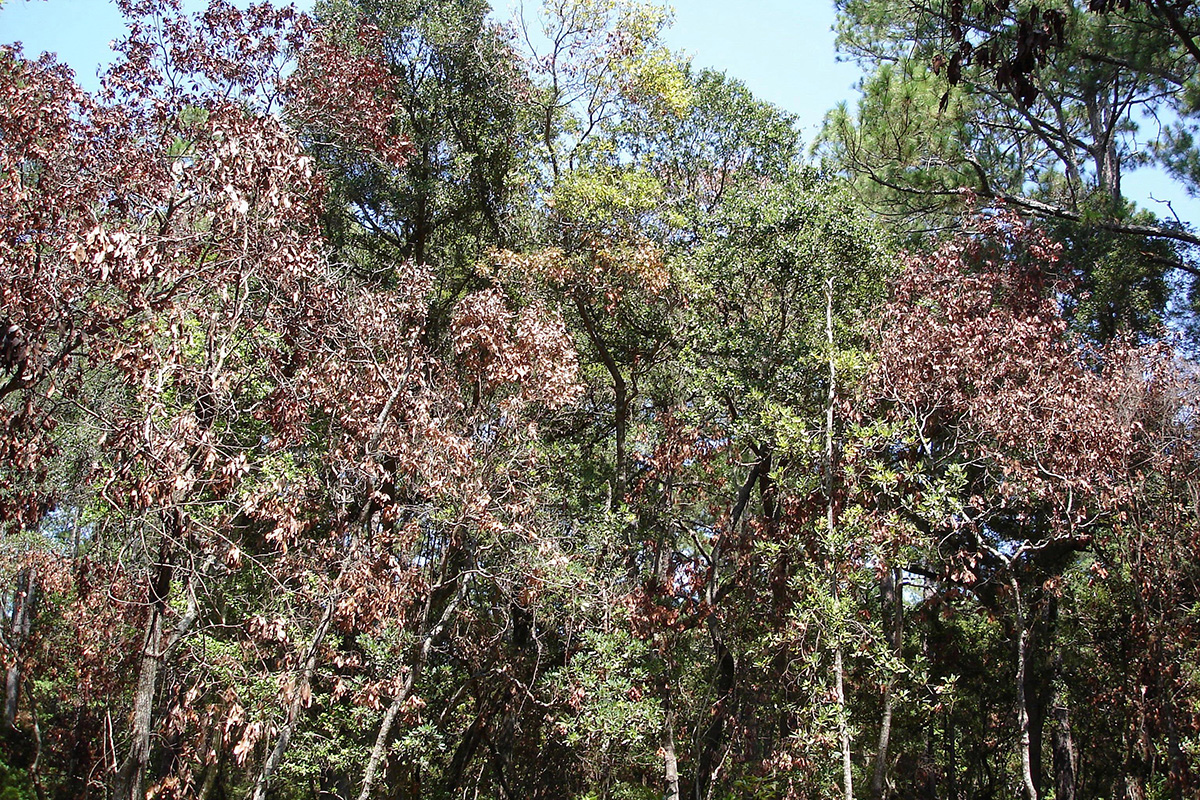
Ambrosia is which of the following? (1) A dessert made of oranges and shredded coconut. (2) A group of beetles that can harm plants in the southeastern United States. The answer is both.
Ambrosia beetles (Xyleborus spp.) are quickly becoming a topic among gardeners and commercial growers across our region. They are wood-degrading insects that live in association with an ambrosia fungus. These beetles and their fungus are in a nutritional symbiosis. In our native woodlands, many types of ambrosia beetles are considered beneficial accelerators of decomposition. This is part of the nutrient cycling that our forests depend on. However, there are some nonnative ambrosia beetles that are impacting our forests and landscapes in a negative way. The following are two species that you need to know about as a home gardener.

Granulate ambrosia beetle
One of the ambrosia beetles we see on a wide range of ornamental trees including redbuds (Cercis spp. and cvs., Zones 4-9), magnolias (Magnolia spp. and cvs., Zones 4-9), and crape myrtles (Lagerstroemia spp. and cvs., Zones 6-9) is the granulate ambrosia beetle (Xylosandrus crassiusculus), native to Asia and distributed in the United States throughout the South and Southeast. There are two main visible signs of infestation. One of them is wilted foliage. The second and easiest to spot is frass tubes, or toothpick-like strands of sawdust protruding from tree trunks. This is commonly seen during the month of March in the Southeast. Adult female beetles bore into small branches and trunks of trees, excavating tunnels and laying eggs. The frass tubes are extruded from the holes they create. During this process, the female beetle also introduces an ambrosia fungus on which she and her larvae feed. Granulate ambrosia beetles’ favorite target is trees that are already weak or stressed. Stressed trees release ethyl alcohol, which aids in attracting the beetles. The best prevention is to water trees during times of extended drought and to avoid mechanical damage to trunks from things like lawnmowers and string trimmers.

Redbay ambrosia beetle
Redbay ambrosia beetle (Xyleborus glabratus), also native to Asia, was first discovered in Georgia in the United States. It has now spread in several areas throughout the South and Southeast. These beetles also create frass tubes, although they are shorter than those created by granulate ambrosia beetles. Additionally, redbay ambrosia beetle is the main vector for the invasive pathogen Raffaelea lauricola, which causes laurel wilt. Laurel wilt is a nasty problem that prevents the movement of water. Trees are literally choked of water, and then they wilt and die. Infected plants die rapidly during the growing season, leaving brown, wilted leaves on the plants and dark streaks in the vascular system just beneath the bark. In its native range, redbay ambrosia beetle impacts a variety of plant species. In the eastern United States, the full list of plants that can be impacted is not currently known. However, laurel wilt definitely impacts all members of the laurel family, including natives like sassafras (Sassafras albidum, Zones 4–9) and Southern spicebush (Lindera benzoin, Zones 4–9). This has the potential to be a major issue for Southeastern forests in the future. One of the best ways to prevent the spread of laurel wilt is to not move firewood. Additionally, if trees die of laurel wilt, the current recommendation is to chip the trees and burn the chips.
Prevention and treatment
There are many species of native ambrosia beetles that don’t typically cause damage to our landscapes. Healthy trees can typically resist infestation. Therefore, maintaining tree health and vitality through proper irrigation, mulching, pruning, and cultural practices are essential. Ambrosia beetles are difficult to control once a tree is infested, so preventive measures are the best option.
There are also commercially available and homemade traps that can prove effective. Homemade traps can be made using ethanol, found in many hand sanitizers. (For information on making your own traps, read on here or here.) These traps need to be monitored regularly and should be placed away from commonly impacted species. Ambrosia beetles become active when temperatures are consistently 70°F or above. Traps are most effective when set out in late winter or early spring.
And if necessary, products containing permethrin or bifenthrin can serve as a prevention or as a rescue treatment if applied quickly after the first sign of attack. Early application is critically important for management.
Gardening is a rewarding pursuit, and hearing about new pests can be discouraging. Knowing how to recognize the pests with potential to cause damage is another step toward prevention.
—Andy Pulte is a faculty member in the plant sciences department at the University of Tennessee.
Fine Gardening Recommended Products

DeWalt Variable-Speed Cordless Reciprocating Saw
Fine Gardening receives a commission for items purchased through links on this site, including Amazon Associates and other affiliate advertising programs.
- 18.31 x 6.13 x 4 inches
- 1-1/8-inch stroke length
- Variable speed trigger with 0-3000 spm

ARS Telescoping Long Reach Pruner
Fine Gardening receives a commission for items purchased through links on this site, including Amazon Associates and other affiliate advertising programs.

The Nature of Oaks: The Rich Ecology of Our Most Essential Native Trees
Fine Gardening receives a commission for items purchased through links on this site, including Amazon Associates and other affiliate advertising programs.



















Comments
Log in or create an account to post a comment.
Sign up Log in